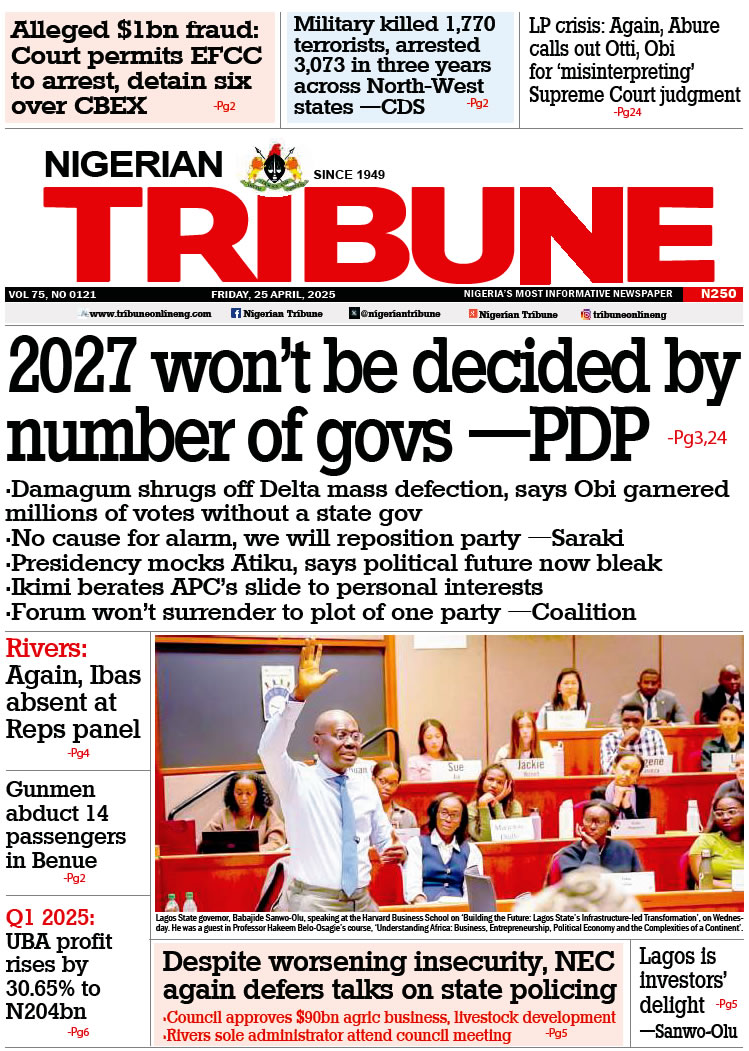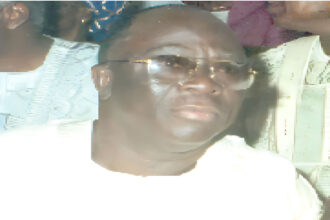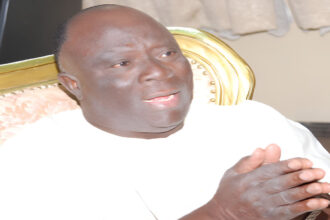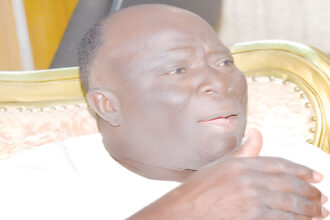Starting a Family
LONG before I was self-conscious, very mature and in search of a woman, I had always been particular about my appearance. I gave it more than enough attention, I took dressing very seriously. Spotless Banjus, the nickname I was called by my classmates and some teachers, right from Form 1 in 1944 at CMS Grammar School, was not for nothing. I elicited admiration, and many looked at me more than twice. Gazes trailed me.
So, anytime I was on holiday (from CMS Grammar School in my senior years), I went to Ijebu Ode where I had my eyes on a cute, young lady, Bimpe Dina. She was herself a student of Ijebu-Ode Girls’ School, and was my neighbour, living opposite my uncle’s house on Gbelegbuwa Street, lyanro.
We enjoyed each other’s company and spent quite a lot of time together. When both of us left secondary school, we remained very close. Everyone knew we had the hots for each other.
By the time I was working at Medical Headquarters as a clerk, Bimpe and I had become an item. She was training to be a nurse at the General Hospital on Broad Street, Lagos.
Living together was the next best option, but we had to become man and wife first, legally. In 1952, at a registry, St. Anna Court, Tinubu, we signed the “dotted lines, became Mr. and Mrs. Ayo Adebanjo.
Princess Street, Lagos, in my bedroom and living room abode when I was barely 24, was where we made home. She was pregnant at the time, and we looked forward to a new tot. When a boy was delivered shortly after our nuptials, we were high-spirited.
But the boy only lived for a few days! We were devastated, inconsolable. It took sometime before we acknowledged the radiance of the sun and accepted our fate. Two years later, in 1954, a child, a daughter (Ayotunde, who later became a teacher), came into our lives.
Work, activism and politics took me around, and Bimpe was not comfortable with my constant absence.
When I was appointed as the Organising Secretary of Remo Division by the Action Group in 1954, and moved to Sagamu, she didn’t leave Lagos. She didn’t come with me to the place I made home for the next three years. She stayed back in Lagos, and only left when she was transferred to Ibadan.
Our marriage became strained. She was becoming intolerant, agitated and unpleasant. The union became painful and joyless. We began to have disagreements over minor family matters. Bimpe filed for divorce in 1955, alleging adultery.
Not quite shocked about the turn of events, I received the divorce papers in Sagamu without any bitterness. I didn’t contest the divorce nor did I go to court to defend myself, so Bimpe went her way, barely three years as Mrs. Adebanjo.
During my tour of many cities and towns as Organising Secretary, I ran into a lot of women. And in Ibadan, I met in attractive and very neat lady, Aduke (a relation of Mr. J. A. Akinlotan, the party’s Financial Secretary) who had come on a visit to her uncle. We began as friends, and later lovers. In no time, she became pregnant. Adeseye, another girl, was born in 1956. However, the relationship with Aduke ended by the time I left for England.
When I got to England. I was unattached and unmarried. Very matured, with ample experience under my belt, I was ready again for matrimony, and this time for keeps. I wanted an enduring and eternal union. I was looking for more than a friend and companion. I wanted a soulmate and an ‘alabars (a confidant). Olaniwun Ajayi, my host in London, already found a lady who would turn out as a perfect match for me.
After all, he knew me well, and was aware of what I desired from the ‘bottom’ of my bosom. Olori Stella Yetunde Gbadebo, too, put in some good words for her. She came highly recommended. Christiana Anoko Magnus-Lawson was on federal government scholarship, on the recommendation of Dr. Moses Adekoyejo Majekodunmi who was then the Chief Gynaecologist at Massey Street Dispensary (now Hospital) and who later founded St. Nicholas Hospital. Lagos. A nurse she was, and the ward of Prelate Bolaji Idowu of the Methodist Church, Nigeria.
Christiana had come with Olori Gbadebo (whom she was staying with in London) to visit the Ajayis. In the course of their discussion, they agreed that if she was unattached, she’d be good for their friend; for me. I was not around. though.
When I returned, Ajayi told me about my good fortune. On their second visit, I was not in too. But they made a phone call to me and I rushed back from a social engagement to see the lady everyone couldn’t stop talking about. My heart pounded, and I was full of expectations on the day set aside for our meeting and matchmaking. I wanted it to go right so fervently. I had a picture of a better half, and I hoped and prayed that she fitted that portrait.
Christiana was herself nervous. She brooded and agonised about how events would turn out. However, she trusted the Ajayis enough to believe that there was ample chance that the new relationship would fly. How far, she wasn’t sure. Everything turned out as if it was well scripted and acted, with gifted performers on stage. Christiana came well-packaged. Her background, a ward of Prelate Idowu was enough to make any man swoon. On top of it, she was cultured, beautiful beyond my imagination. We started on a good note, discussing safe subjects.
I arranged to take her out (this was in late 1959), and we fixed another date. We went to a cinema and took it off from there, spending time together, and building a dream, a future, as a pair.
It was a jolly time full of sunny and bright moments. Events cascaded into a pool of happiness and laughter with marriage as the destination of choice. But it wasn’t that easy. Prelate Idowu’s approval had to be sought and granted. And when he came to London, Christiana informed him about me. As I had anticipated, he demanded that he wanted to see the young suitor.
The meeting was arranged, and ‘reported myself at Methodist International House where the clergy lodged. He interrogated me and asked if I was married before, and I told him I was, but divorced. The Prelate was taken aback. And he thundered, ‘Who was the guilty party?”
“Sir, there is no use talking about that now, because there is no way you can corroborate what I tell you. The fact of the matter is that the divorce was undefended.”
Prelate Idowu went on, “Don’t you think it’s too much of a risk for her to marry a divorcee?”
I didn’t hesitate. ‘I bear the greater risk because I cannot afford another failed marriage. If this marriage fails, I’m culpable in the eyes of the world. It is mandatory that I ensure it works Prelate Idowu was quiet, and didn’t say anything again. (When Christiana and I saw thereafter, she told me the comment of the Prelate: that I would be a tough guy, difficult to handle by the way I answered a seemingly difficult question).
On the eve of my Bar exams, I was also occupied as a Secretary of the London branch of Action Group. In 1960, when activities were frenetic at home about Independence and a new dawn, we fixed our wedding for May 7. But we had to postpone it till May 14 because Princess Margaret, the Queen of England’s younger sister) was getting married to Anthony Armstrong Jones (first Earl of Snowdon) that day, and many of the guests, Nigerians attending the Constitutional Conference in London, were also invited for the royal wedding.
But the May 14 ceremony almost never took place. It was discovered at the Registry, Lambert Registry, that I was officially still married unless I produced the divorce certificate of the previous marriage.
In the marriage form, I had stated that I was married. They asked for the divorce papers which I had never set my eyes on. I had to send a registered mail to my friend, Mosunmola Folarin (a timber merchant I had known in Sagamu) to help procure the papers which were posted to England in time before the May 14 date.
Those who were attending the Constitutional Conference in London and also the wedding of Princess Margaret, stayed on to grace our nuptials. There were many high-ranking party officials and Western Region government functionaries.
The wedding took place at the Anglican Church at Ann Hill, London with Oniyide Sodipo, also a law student at the time and father of Prof. Kole Sodipo), my childhood friend testman. This was followed by a reception at the Age bels house, 15A Kensington Palace Gardens, London. It was a high society event with Chief Samuel Ladoke Akintola (the then Premier of Western Region) as chairman of the reception, and Chief Toye Coker, who was then the Agent-General, as master of ceremony. (Kensington Palac Gardens was, and still is, London’s most exclusive addres and had one of the world’s most expensive residential street with embassies and residences of ambassadors). The property was bought by the Action Group Government under C Awolowo when M.E.R. Okorodudu was the Agent-General (The military later took it over from Western Nigeria and converted it to Nigeria House). Also in attendance were Chief ERA. Williams (Attorney-General of Western Region), 5.0 Ighodaro, J.A.O. Odebiyi, among many other dignitatis from Nigeria. Chief Awolowo was not in England at the time. The wedlock, blessed with four children, two male and two female, has lasted over 50 years already – through the valleys and peaks of trials and triumphs as a politician activist, lawyer, businessman and elder statesman, apart frees the years of exile, detention and imprisonment.
It has survived all, with beautiful children who now parents. There is Adeola, born in 1960, a lawyer banker, Obafemi, 1962, who studied political science, and doing business in London: Olusegun, 1968, a lawyer in New York; and Folasade, 1972, a medical doctor and currently a consultant.
Culled from Telling It As It Is,
Ayo Adebanjo’s autobiography
READ ALSO: Oyinlola tackles Akande over allegations in his autobiography








